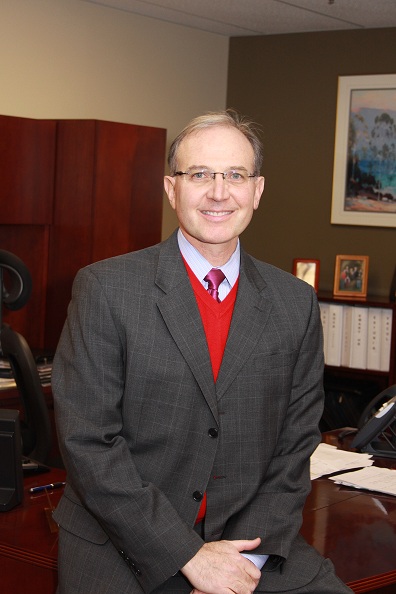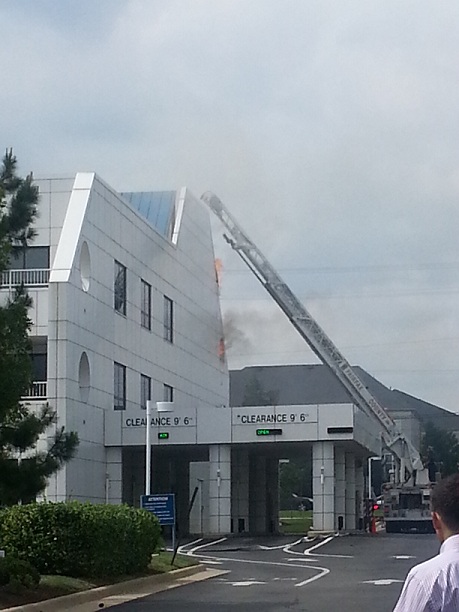 On a humid summer day whenroofers are using blow torches to seal in black tar, at the most, afew employees working in that building may grumble about the smellor the noise.
On a humid summer day whenroofers are using blow torches to seal in black tar, at the most, afew employees working in that building may grumble about the smellor the noise.
But at the $277 million Fairfax County Federal Credit Union, theusual construction activity quickly morphed into an emergency thatwould put the Fairfax, Va., cooperative's disaster recovery plan tothe test and endear it even more to its county workers-heavy fieldof membership.
|For his even-keeled temperament that helped save one person'slife, moved staffers to safety and got his credit union back up andrunning within 24 hours after a fire, Joe Thomas Jr., president/CEOof Fairfax County FCU, has been named Credit Union Times’2014 Trailbazer CEO of the Year.
|While recovery after the fire was a top headline last year, itdidn't overshadow Fairfax's 50% surge in loan growth 2013 that camethrough a number of strategies to capitalize on local refinancingdemand,F as well as a bold shift away from aging checking accountoptions.
|The day of the blaze, July 11, 2013, was fairly routine atFairfax County FCU. Thomas said he had noticed a couple of waterspots in the computer room. A roofer was hired to seal the tarbetween the deck and the building. As the roofer sealed the tar, hedidn't realize that plywood had caught fire from his blowtorch,Thomas recalled.
|As the roofer worked on top of the building all that week,everyone could smell the tar but it hadn't been any worse thanbefore. Suddenly, the credit union's fire alarm went off, Thomassaid. The employees spilled out into parking lot and Thomas checkedthe building to ensure it was vacant.
|He noticed the roofer was still on the deck sealing the tar.Thomas made his way to him and told him he needed to leave. Insteadof coming through a heavy door, the roofer said he would come downhis work ladder. Thomas insisted he come through the door.
|By this time, the sound of fire engines could be heard in thebackground. Soon, firefighters showed up at Fairfax with theircrowbars ready. Thomas told them what happened, that he had all thekeys and there was really no need to bash any of the building'sdoors in.
|The fire chief said the smoke detector triggered the airconditioning unit and if Thomas could go back in the building andshut the device off, employees would be let back in to retrievetheir belongings.
|The firefighters were all members of the credit union and jokedabout whether they were going to get paid since the following daywas a county payroll day.
|Read more: Meanwhile, back on the roof...
|| “I walked up three flights ofstairs to turn off the AC, which is next to my office,” Thomassaid. “As I’m walking back down, I see a lot of thick smoke so Ithought I’d open the windows and doors for some fresh air.”
“I walked up three flights ofstairs to turn off the AC, which is next to my office,” Thomassaid. “As I’m walking back down, I see a lot of thick smoke so Ithought I’d open the windows and doors for some fresh air.”
As he entered one of the rooms, he was startled to see theroofer trying to put a fire out. Thomas said he quickly grabbed afire extinguisher to help smother the blaze, but was unable to andran back up the stairs. Panicked, the roofer who was worried abouttracking tar on the carpet, had to literally be pulled by Thomasout to the parking lot.
|The firefighters sprang into action, turning on their waterhoses to extinguish the flames that had started underneath thoseplywood panels and was spreading. In the end, the two-alarm firewas squelched and no one was injured.
|The good news is there wasn't any structural damage, Thomasnoted. By that night, the credit union was up and running, servingmembers.
|Thomas said he stayed until 11:30 p.m., went home for a fewhours and came back at 4:30 in the morning to continue prepping forthe next day's county payroll processing. He rented a few hotelrooms nearby for staff, many of who had to remain in the parkinglot under cooling tents on the hot day because the fire engines hadblocked their cars in for several hours.
|Looking back, for the approximately 30 employees and members –and the roofer – who were in the building when the fire alarm, theoutcome could have been much worse, Thomas said. The claims fordamage were more than $400,000 to pay for the water-damagedcomputer room, replace the plywood panels, drywall and tiles andclear out the smoke odor and stains and treat for moldprevention.
|What also helped saved Fairfax was a disaster recovery plan thatwas finalized and tested a few months earlier.
|Lessons learned? After the fire, Thomas and his team had aseries of meetings to assess.
|“Hindsight is always 20/20. One thing we started doingdifferently in the planning process is instead of planning for aflood, fire or tornado, let's start planning by systems in thecredit union,” Thomas said. “What would we do if a system is downand how will the other systems react? One of my favorite quotescomes from Dwight D. Eisenhower – plans are useless when they areneeded but planning is essential.”
|Read more: A record lending year...
|Meanwhile, recovering after the fire came inthe middle of a record lending year for Fairfax during a time whenmany credit unions were grappling with tepid loan growth. Thanks toresurgence in real estate in the area, at $146 million, Fairfax's2013 loan portfolio grew nearly 50% over 2012's figure, Thomassaid.
|First mortgages that were held grew more than 10% last year withFairfax selling $4.7 million of them. The surge in real estatelending was also helped along by the credit union's conversion to acommunity charter nearly seven years ago. Still, county workersremain Fairfax's membership core.
|Two years ago, the credit union dipped its toe in businesslending but it was in 2013 when it started to see robust activity,mostly through participation loans, Thomas said. A CUSO that wasn'table to secure loans in Fairfax County resulted in the cooperativebeing the lead lender on some of the loans. At year-end, the creditunions had amassed $17 million in business loans.
|Fairfax also took a hard look at its checking accounts anddecided it was time for a revamp. As with many credit unions andbanks, it had a plethora of accounts including for those over 50,working professionals and families.
|“We found out that whatever name we called it, young people justdidn't care. It was too old school,” Thomas said.
|So Fairfax consolidated all of its checking account into twoofferings. The result was the debut of its Shift and Shift Upchecking accounts which downplayed the word “checking” andemphasized convenient access at ATMs, retailers and beyond, Thomasexplained. At the end of 2013, more than 1,500 accounts hadopened.
|“We’re not competing with other banks, we’re competing againststored value cards,” Thomas said. “I just put this money on my cardand can use it anywhere. People my age think one way and thinkeveryone else thinks the same. We have to figure out where (others)are coming from.”
|Thomas got his start with credit unions as part of his servicein the United States Peace Corp in the 1980s when he managed thelargest regional field office for the Malawian Union of Savings andCredit Cooperatives, the national credit union trade association inMalawi. A move back to the U.S. led to an assistant manager job atFairfax in 1994 and in 1999, he was promoted to president/CEO.
Complete your profile to continue reading and get FREE access to CUTimes.com, part of your ALM digital membership.
Your access to unlimited CUTimes.com content isn’t changing.
Once you are an ALM digital member, you’ll receive:
- Critical CUTimes.com information including comprehensive product and service provider listings via the Marketplace Directory, CU Careers, resources from industry leaders, webcasts, and breaking news, analysis and more with our informative Newsletters.
- Exclusive discounts on ALM and CU Times events.
- Access to other award-winning ALM websites including Law.com and GlobeSt.com.
Already have an account? Sign In
© 2024 ALM Global, LLC, All Rights Reserved. Request academic re-use from www.copyright.com. All other uses, submit a request to [email protected]. For more information visit Asset & Logo Licensing.









